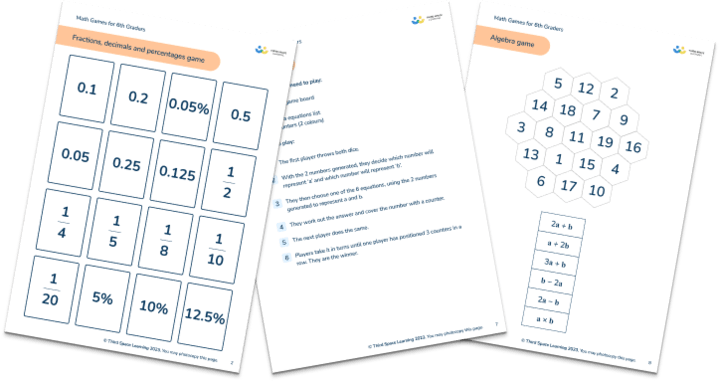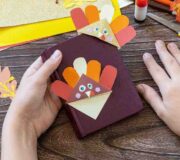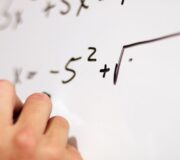Math Games For Your Grade 6 Students: Fun, Free Math Activities (No Screens Required!)
Math games for grade 6 are important to include in lesson planning. The sixth grade and middle school math curriculum is more diverse and varied than that of elementary school. As students transition into middle school, math concepts get more challenging and math lessons become more structured. Math games are a good way to lighten up the class time load but still strengthen students’ math skills.
In middle school, new math concepts are introduced and concepts that students are already familiar with from elementary school, get expanded and taken to the next level of complexity.
When to use math games in grade 6
The transition from elementary school into middle school is a big one and 6th graders can often feel overwhelmed: they may be in a new school, need to make new friends, have different teachers and more challenging class work.
Sixth grade math is one of these areas that can be intimidating for children. Fun math games and math activities can be a good way to make math feel a little less scary. Consider starting a lesson with a fun math game to get sixth graders into the ‘doing math’ mindset.
A funny math problem, game or math puzzle can also be a good way to end a lesson as they can leave students feeling upbeat and positive about learning math – something that is crucial for young mathematicians. Using these activities as an exit ticket also provides the teacher with a low-stakes means of assessing students’ understanding of the day’s lesson.
See also:
- 3rd grade math games
- 4th grade math games
- 5th grade math games
- 7th grade math games
- 8th grade math games
Math Games for 6th Graders
6 printable games for 6th graders that can be played in pairs, teams or as a whole class as a fun way to build math skills.
Download Free Now!How to use these grade 6 math games
The free math games listed below are simple to use and require very few resources. All of the games suggested can be easily adapted to suit different levels of difficulty as well as adapted to different topic areas.
We hope that these games are enjoyed by you and your students and can provide ideas for you to create your own math games.
Prime numbers game
This fun maths game gets children thinking about prime numbers and factors, to determine whether they have the cards to make a prime number each time.
What you will need to play:
- 2 or more players
- Pack of cards (Ace = 1, Jack = 11, Queen = 12 and King = 13)
- List of prime numbers (optional): 2, 3, 5, 7, 11, 13, 17, 19, 23, 29, 31, 37, 41, 43, 47, 53, 59, 61, 67, 71, 73, 79, 83, 89, 97, 101, 103, 107, 109, and 113
How to play:
- Shuffle the cards and deal 11 cards to each player, which they hold in their hand. The top card of the remainder of the pack is turned over and is the ‘starting number’.
- The non-dealer (or person to the left of the dealer) adds a card from their hand that adds to the starting card to equal a prime number.
- The next player then tries to add to that total to equal a larger prime.
- When a player can no longer add a card that sums up to a prime the hand is over, and the last person to make a prime gets a point.
The first player to score 5 points is the winner.
Multiplication game: product hunt
This game enables children to practise the written method of multiplication in a more fun and motivational way than just working through calculations on a worksheet.
What you will need to play:
- 2 players
- 0-9 digit cards
- Paper and pen
How to play:
- Shuffle the cards and place in the middle of the table, face down.
- Players take it in turns to take a card and place it face up on the table.
- Continue until 5 cards have been selected.
- Once the 5 cards have been chosen, players have 2 minutes to make as many long multiplication questions and calculate the correct answers as they can (e.g. if the cards 2, 9, 5, 6 and 1 were chosen, they could write down the calculation 291 x 56.
- The winner is the player with the most correct calculations completed in the 2 minutes.
Fractions, decimals and percentages game: snap
In sixth grade, children need to be able to recognise equivalent fractions, decimals, place value and percentages. This game is a simple way of practising this in a more engaging and fun way than working through a worksheet.
For an extra challenge, add some roman numerals cards.
What you will need to play:
- 2 players
- A set of shuffled fraction, decimal and percentage cards (see printable resource pack)
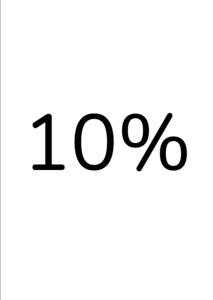
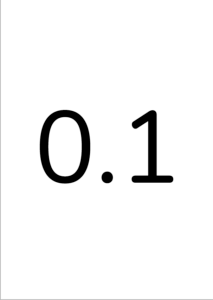
How to play:
- Place the shuffled pile of cards face down on the table.
- Take it in turns to turn over a card. If 2 cards are turned over with matching fractions/decimals/percentages e.g. 50% and ½, then the first player to call out ‘snap’ gets to keep all the cards put down so far.
- The winner is the player at the end of the game with the most pairs of cards.
Multiplying / dividing fractions game
This game can be used for both multiplying and dividing fractions, as well as comparing the size of 2 fractions. This game really gets children thinking, as they have to think carefully where to position their digits to make the largest fraction.
This game can also be adapted to cover adding and subtracting fractions.
What you will need to play:
- 2 players
- A set of 1-9 cards
- Blank fractions sheet with multiplying or dividing questions (see printable resource pack)
- Pen
- Dice
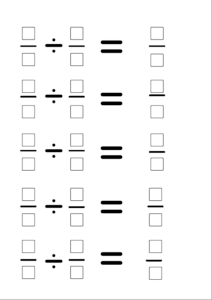
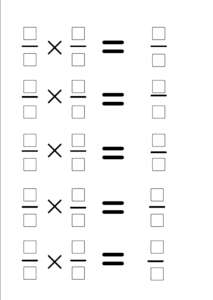
How to play:
- Each player has a blank multiplying or dividing fractions page.
- Take it in turns to throw the dice and each player decides which box on their sheet to put the number in.
- Once the numbers have been generated and all 4 boxes contain a number, each player multiplies their fractions together (or they can divide the fractions if this is the focus).
- The player who has made the greatest fraction, when the 2 are multiplied or divided, scores 2 points.
- If both players make the same sized fraction, each player scores 1 point.
- The winner is the first player to reach 10 points.
Algebra game: 3 in a row
In sixth grade, children build on the algebra skills learnt in 5th grade and start applying the skills that will take them through to high school. This game is a great way to practise algebraic equations and more fun than simply answering questions from a textbook.
What you will need to play:
- 2 players
- Algebra game board (see printable resource pack)
- 2 dice
- Algebra equations list (see printable resource pack)
- 20 counters (2 colours)
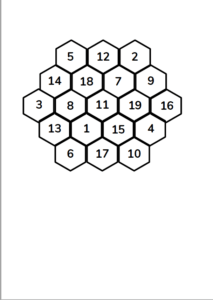
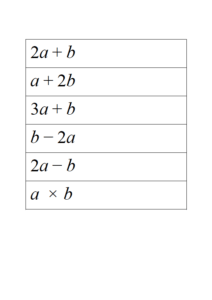
How to play:
- The first player throws both dice.
- With the 2 numbers generated, they decide which number will represent ‘a’ and which number will represent ‘b’.
- They then choose one of the 6 equations, using the 2 numbers generated to represent a and b.
- They work out the answer and cover the number with a counter.
- The next player does the same.
- Players take it in turns until one player has positioned 3 counters in a row. They are the winner.
Coordinates game: battleships
In this game, players must identify all the coordinates of their opponent’s battleships. It can be played using a 2 or a 4 quadrant grid and is great for practising the reading and plotting of coordinates.
What you will need to play:
- 2 players
- A blank coordinates grid, A – I on the x-axis and 1 – 9 on the y-axis, for each player (see printable resource pack)
- A pen for each player
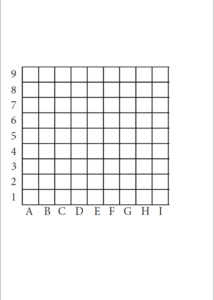
How to play:
- Each player has a blank coordinate grid.
- They plot their ‘battleships’ (make sure the size and number of battleships are agreed in advance) on the grid and make a note of the coordinates.
- Player 1 goes first and calls out their first coordinate. If it hits one of the coordinates on player 2’s grid, player 2 calls out ‘hit’ and player 1 marks it off. If it misses player 2’s battleships, they call out ‘miss’ and player 1 marks it as a miss.
- Players then swap over, so player 2 calls out their first coordinate. As before, player 1 calls out ‘hit’ or ‘miss’
- Once a battleship has had all the coordinates called out, the player who’s battleship it is shouts ‘battleship sunk’. The other player marks this on their grid.
- The winner is the first person to sink all the other player’s battleships.
Exponent Compare!
This is a fast-paced game where students compare exponents.
What you will need to play:
- ‘Exponent Compare’ cards
- A partner
How to play:
- Cut out the cards from the ‘Exponent Compare’ sheet. Shuffle them and deal them between both players.
- At the same time, each player turns over one card. The player who has the largest value number gets to collect the cards and add them to their pile.
- As an added challenge, players can be given a 5 second time limit to determine which card has the higher value; if the player with the highest value doesn’t collect the cards within 5 seconds, the other player can take the cards.
- The person who gets all the cards first wins!
Example cards for printable resource:
5³ | 2³ | 4² | 2¹ |
4³ | 5² | 7³ | 6¹ |
6³ | 9² | 3³ | 10⁴ |
2⁶ | 2⁴ | 4⁴ | 5¹ |
8² | 8¹ | 9¹ | 8³ |
3¹ | 5⁴ | 3⁴ | 10⁵ |
9³ | 3² | 10³ | 2² |
2⁵ | 4⁵ | 7¹ | 7² |
10² | 6² | 3⁵ | 10⁶ |
The 24 Game
This math game is a great problem solving and ‘low floor, high ceiling’ game, as players search for a solution. They can use basic calculations to reach the target number or they can utilize much more complex mathematical calculations.
What you will need to play:
- 2 or more players
- A pack of cards (number cards only)
How to play:
- Shuffle the pack of cards and lay them face down on the table.
- Each player picks a card and turns it face up on the table until there are 4 cards displayed.
- The aim of the game is to make ‘24’ using only the cards on the table and any of the 4 operations.
- For example, if they have a 6, 10, 2, and 6, the solution could be very simple, such as basic addition: 6 + 10 + 2 + 6 = 24
- To incorporate the order of operations, however, students can create more complex operations involving parentheses. For example, they may have 9, 5, 6, and 9 and solve it by creating the equation 5 – (9 ÷ 9) x 6 = 24.
- If no players are able to reach 24, the player who is the closest wins.
Estimate Volume
In this game, students challenge their estimation skills by guessing the volume of 3D objects within the classroom before measuring the actual volume.
What you need to play:
- Plain paper
- Tape measure or ruler
How to play:
- Create a list of 3D objects in the classroom with a measurable length, width, and height. (For example, a book!) The items can be large or small. Try to list at least 20 items.
- Next to each item, write an estimate of its length, width, and height, and then multiply them together to get an estimate of the item’s volume.
- Then, measure the items and calculate their actual volumes.
- Compare your estimates to the real answers. How accurate were you?
GCF Match
This math activity can be played whole-class, in a small group, or with a partner. Students work together to find the greatest common factor of two numbers.
What you need to play:
- Index cards with a two-digit number written on each one (It may be most helpful to use numbers that are found in the 1-12 times table.)
- A partner or group
How to play:
Whole-class:
- Each student gets one index card.
- Students walk around the room until you yell ‘stop!’ When they hear ‘stop,’ they must partner up with the classmate that is closest to them at that time. (You could also play music and students stop and partner up when the music stops.)
- The two partners find the GCF of the two numbers on their index cards. (Example: if partner A has 16 and partner B has 24, they should determine that the GCF between their numbers is 8.
- Continue until all students have partnered up.
- As a challenge, you may ask 3 or 4 students to partner up at the signal and work together to find the GCF of all their numbers.
Partner or small group:
- Students are given a stack of index cards with a two-digit number written on each one.
- Students shuffle the cards and distribute them evenly amongst themselves.
- At the same time, students flip a card and work together to find the GCF.
- The game ends when all cards have been played. Students can then shuffle and start over.
Human Number Line
This is a whole-class activity where students have an opportunity to create a number line using positive and negative integers.
What you need to play:
- Index cards: labeled from -20 to 10. (This can change depending on how many students are in your class, but it is important to have both negative and positive integers as well as the number zero.)
How to play:
- Shuffle the index cards and give one to each student.
- Task the students to create a real-life number line by ordering themselves from least to greatest.
- This can be adapted to a small group or partner activity, where students are given a set of index cards and must order them together.
Read more
Do you have students who need extra support in math?
Give your students more opportunities to consolidate learning and practice skills through personalized math tutoring with their own dedicated online math tutor.
Each student receives differentiated instruction designed to close their individual learning gaps, and scaffolded learning ensures every student learns at the right pace. Lessons are aligned with your state’s standards and assessments, plus you’ll receive regular reports every step of the way.
Personalized one-on-one math tutoring programs are available for:
– 2nd grade tutoring
– 3rd grade tutoring
– 4th grade tutoring
– 5th grade tutoring
– 6th grade tutoring
– 7th grade tutoring
– 8th grade tutoring
Why not learn more about how it works?
The content in this article was originally written by content team Vanessa Sipple-Asher and has since been revised and adapted for US schools by elementary math teacher Katie Keeton.

